A shared transcription termination signal on negative and ambisense RNA genome segments of Rift Valley fever, sandfly fever Sicilian, and Toscana viruses
- PMID: 17329326
- PMCID: PMC1900212
- DOI: 10.1128/JVI.02778-06
A shared transcription termination signal on negative and ambisense RNA genome segments of Rift Valley fever, sandfly fever Sicilian, and Toscana viruses
Abstract
The Phlebovirus genus (family Bunyaviridae) is composed of a diverse group of arboviruses that cause disease syndromes ranging from mild febrile illness to hemorrhagic fever with high fatality. Although antigenically similar, these viruses differ by approximately 25% at the genome level, and their ecologies, including geographic ranges, preferred vector species, and hosts, vary considerably. In contrast to other ambisense viruses, where RNA hairpin structures which serve as transcription termination signals are frequently found separating the opposite-sense open reading frames, no evidence of predicted high-energy hairpin structures was found at the ambisense junctions of phlebovirus S RNA segments. However, a conserved sequence motif was identified on both negative and ambisense genome segments that functions as a transcription termination signal for the N, NSs, and GPC mRNAs in three diverse phleboviruses, namely, Rift Valley fever, sandfly Sicilian, and Toscana viruses. The exact termination of nascent virus mRNA molecules was determined by 3' rapid amplification of cDNA ends. Surprisingly, analysis of the termini of mRNAs from both S and M segments of these three viruses revealed that transcription termination occurred immediately upstream of a conserved sequence motif with the general features 3'-C(1-3)GUCG/A-5'. In contrast, no corresponding sequence motif was found in the L segments, and analysis indicated a "runoff" transcript approach to L mRNA termination. The absolute requirement of the identified transcription termination motif was demonstrated by using a highly efficient Rift Valley fever virus reverse genetics system to generate live recombinant viruses with S segments lacking the termination signal motif for the NP or NSs mRNA and showing that these recombinant viruses generated mRNAs that failed to terminate correctly.
Figures
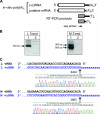
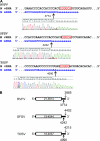
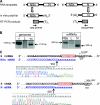


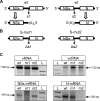
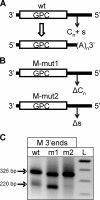
References
-
- Barr, J. N., J. W. Rodgers, and G. W. Wertz. 2006. Identification of the Bunyamwera bunyavirus transcription termination signal. J. Gen. Virol. 87:189-198. - PubMed
-
- Bird, B. H., C. G. Albarino, and S. T. Nichol. Rift Valley fever virus lacking the NSm proteins retains high virulence in vivo and may provide a model of human delayed onset neurologic disease. Virology, in press. - PubMed
-
- Bird, B. H., M. L. Khristova, P. E. Rollin, T. G. Ksiazek, and S. T. Nichol. 2007. Complete genome analysis of 33 ecologically and biologically diverse Rift Valley fever virus strains reveals widespread virus movement and low genetic diversity due to recent common ancestry. J. Virol. 81:2805-2816. - PMC - PubMed
-
- Buchmeier, M. J., M. D. Bowen, and C. J. Peters. 2001. Arenaviridae: the viruses and their replication, p. 1635-1668. In D. M. Knipe, P. M. Howley, D. E. Griffin, R. A. Lamb, M. A. Martin, B. Roizman, and S. E. Straus (ed.), Fields virology, 4th ed. Lippincott Williams & Wilkins, Philadelphia, PA.
Publication types
MeSH terms
Substances
LinkOut - more resources
Full Text Sources
Other Literature Sources
Miscellaneous

